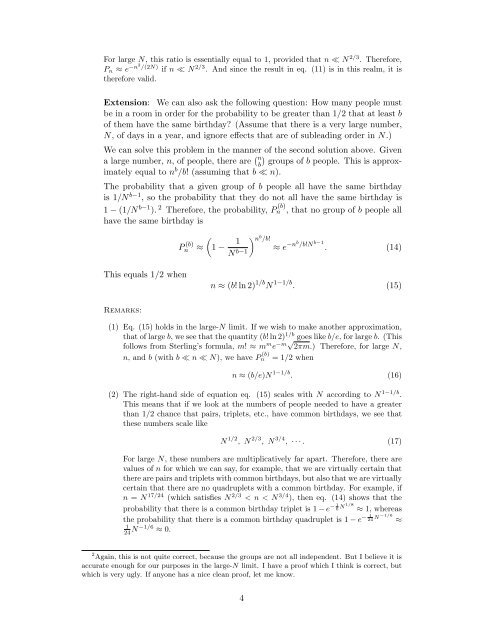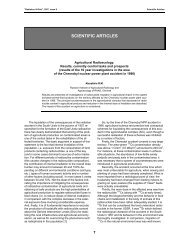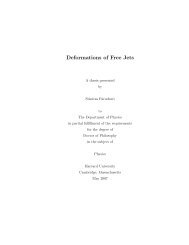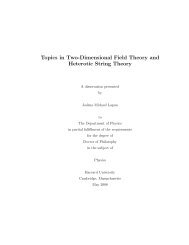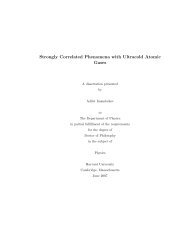Solution Week 46 (7/28/03) The birthday problem (a) Given n people ...
Solution Week 46 (7/28/03) The birthday problem (a) Given n people ...
Solution Week 46 (7/28/03) The birthday problem (a) Given n people ...
You also want an ePaper? Increase the reach of your titles
YUMPU automatically turns print PDFs into web optimized ePapers that Google loves.
For large N, this ratio is essentially equal to 1, provided that n ≪ N 2/3 . <strong>The</strong>refore,<br />
Pn ≈ e −n2 /(2N) if n ≪ N 2/3 . And since the result in eq. (11) is in this realm, it is<br />
therefore valid.<br />
Extension: We can also ask the following question: How many <strong>people</strong> must<br />
be in a room in order for the probability to be greater than 1/2 that at least b<br />
of them have the same <strong>birthday</strong>? (Assume that there is a very large number,<br />
N, of days in a year, and ignore effects that are of subleading order in N.)<br />
We can solve this <strong>problem</strong> in the manner of the second solution above. <strong>Given</strong><br />
a large number, n, of <strong>people</strong>, there are �n� b groups of b <strong>people</strong>. This is approximately<br />
equal to nb /b! (assuming that b ≪ n).<br />
<strong>The</strong> probability that a given group of b <strong>people</strong> all have the same <strong>birthday</strong><br />
is 1/N b−1 , so the probability that they do not all have the same <strong>birthday</strong> is<br />
1 − (1/N b−1 ). 2 <strong>The</strong>refore, the probability, P (b)<br />
n , that no group of b <strong>people</strong> all<br />
have the same <strong>birthday</strong> is<br />
This equals 1/2 when<br />
Remarks:<br />
P (b)<br />
�<br />
n ≈ 1 − 1<br />
N b−1<br />
�nb /b!<br />
≈ e −nb /b!N b−1<br />
. (14)<br />
n ≈ (b! ln 2) 1/b N 1−1/b . (15)<br />
(1) Eq. (15) holds in the large-N limit. If we wish to make another approximation,<br />
that of large b, we see that the quantity (b! ln 2) 1/b goes like b/e, for large b. (This<br />
follows from Sterling’s formula, m! ≈ m m e −m√ 2πm.) <strong>The</strong>refore, for large N,<br />
n, and b (with b ≪ n ≪ N), we have P (b)<br />
n = 1/2 when<br />
n ≈ (b/e)N 1−1/b . (16)<br />
(2) <strong>The</strong> right-hand side of equation eq. (15) scales with N according to N 1−1/b .<br />
This means that if we look at the numbers of <strong>people</strong> needed to have a greater<br />
than 1/2 chance that pairs, triplets, etc., have common <strong>birthday</strong>s, we see that<br />
these numbers scale like<br />
N 1/2 , N 2/3 , N 3/4 , · · · . (17)<br />
For large N, these numbers are multiplicatively far apart. <strong>The</strong>refore, there are<br />
values of n for which we can say, for example, that we are virtually certain that<br />
there are pairs and triplets with common <strong>birthday</strong>s, but also that we are virtually<br />
certain that there are no quadruplets with a common <strong>birthday</strong>. For example, if<br />
n = N 17/24 (which satisfies N 2/3 < n < N 3/4 ), then eq. (14) shows that the<br />
1 1/8<br />
− 6 N<br />
probability that there is a common <strong>birthday</strong> triplet is 1 − e ≈ 1, whereas<br />
1 −1/6<br />
− the probability that there is a common <strong>birthday</strong> quadruplet is 1 − e 24 N ≈<br />
1<br />
24 N −1/6 ≈ 0.<br />
2 Again, this is not quite correct, because the groups are not all independent. But I believe it is<br />
accurate enough for our purposes in the large-N limit. I have a proof which I think is correct, but<br />
which is very ugly. If anyone has a nice clean proof, let me know.<br />
4


